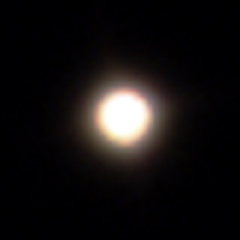







| BOOKS | F. A. Q. | ARTICLES | TALKS | ABOUT KEN | DONATE | BEYOND OUR KEN |
|---|
By Ken Croswell
Published on ScienceNOW (December 18, 2012)

Sunlike star: Tau Ceti is so close to us that it's visible to the naked eye. Credit: Mikko Tuomi/University of Hertfordshire.
Astronomers have discovered what may be five planets orbiting Tau Ceti, the closest single star beyond our solar system whose temperature and luminosity nearly match the Sun's. If the planets are there, one of them is about the right distance from the star to sport mild temperatures, oceans of liquid water, and even life. Don't pack your bags just yet, though: the discovery still needs to be confirmed.
Tau Ceti is only 12 light-years from Earth, just three times as far as the Sun's nearest stellar neighbor, Alpha Centauri. Tau Ceti resembles the Sun so much that astronomer Frank Drake, who has long sought radio signals from possible extraterrestrial civilizations, made it his first target back in 1960. Unlike most stars, which are faint, cool, and small, Tau Ceti is a bright G-type yellow main-sequence star like the Sun, a trait that only 1 in 25 stars boasts. Moreover, unlike Alpha Centauri, which also harbors a G-type star and even a planet, Tau Ceti is single, so there's no second star in the system whose gravity could yank planets away.
Astronomer Mikko Tuomi of the University of Hertfordshire in the United Kingdom and his colleagues analyzed more than 6000 observations of Tau Ceti from telescopes in Chile, Australia, and Hawaii. As the researchers will report in Astronomy and Astrophysics, slight changes in Tau Ceti's motion through space suggest that the star may be responding to gravitational tugs from five planets that are only about two to seven times as massive as Earth.
If that's right, all five planets lie closer to their star than Mars does to ours; however, Tau Ceti emits only 45 percent as much light as the Sun, so each planet receives less warmth than a planet would at the same distance from our Sun. Tau Ceti's three innermost planets�designated b, c, and d�are probably too hot to support life, being so close to the star that they require only 14, 35, and 94 days to complete an orbit. The farthest of the three, d, is about as close to Tau Ceti as Mercury is to the Sun.
It's the fourth planet�planet e�that the scientists suggest might be another life-bearing world, even though it's about four times as massive as Earth. If you lived there, you'd see a yellow sun in the sky, but your year would last just 168 days. That's because Tau Ceti e lies somewhat closer to its star than Venus does to the Sun and thus revolves faster than Earth. The fifth and outermost planet, designated Tau Ceti f, completes an orbit every 640 days and is slightly closer to its star than Mars is to the Sun.
However, Tuomi's team warns that disturbances on the star itself, rather than orbiting planets, may be producing the small velocity changes in Tau Ceti. "They're really digging deep into the noise here," says Sara Seager, an astronomer at the Massachusetts Institute of Technology in Cambridge who was not part of the team. "The [astronomical] community is going to find it hard to accept planet discoveries from signals so deeply embedded in noise."
"They're pushing the envelope," says Gregory Laughlin, an astronomer at the University of California, Santa Cruz. "Some or even many of these planets could go away. But I think that they've done absolutely the best job that you can do, given the data." Laughlin says it's frustrating that the most interesting planets�small ones like Earth�are so challenging to detect: "You have to get tons and tons and tons of velocity measurements over many years, and then you really, really have to take extreme care�as this Tuomi et al. paper does�to get rid of all the systematic noise."
Team member Chris Tinney, an astronomer at the University of New South Wales in Sydney, Australia, acknowledges the problem. "It's certainly very tantalizing evidence for potentially a very exciting planetary system," Tinney says, but he adds that verifying the discovery may take 10 years, and the scientists didn't want to wait that long. "We felt that the best thing to do was to put the result out there and see if somebody can either independently confirm it or shoot it down."
If the planets exist, they orbit a star that's about twice as old as our own, so a suitable planet has had plenty of time to develop life much more advanced than Homo sapiens. That may just explain why no one from Tau Ceti has ever contacted beings as primitive as us.
Ken Croswell earned his Ph.D. in astronomy from Harvard University and is the author of The Alchemy of the Heavens and The Lives of Stars.
"An engaging account of the continuing discovery of our Galaxy...wonderful." --Owen Gingerich, The New York Times Book Review. See all reviews of The Alchemy of the Heavens here.
"A stellar picture of what we know or guess about those distant lights."--Kirkus. See all reviews of The Lives of Stars here.
| BOOKS | F. A. Q. | ARTICLES | TALKS | ABOUT KEN | DONATE | BEYOND OUR KEN |
|---|